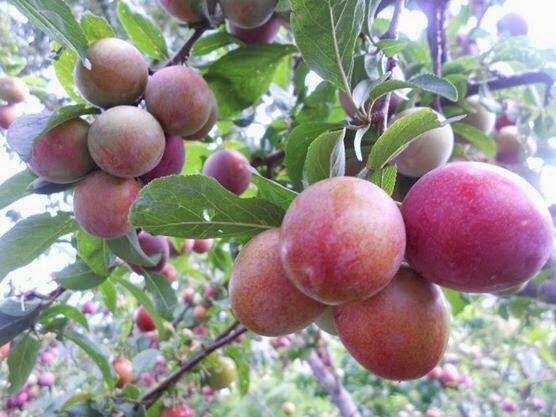Nepali Mother's Day - Aamaako Mukh Herne Din or Maataa Tirtha Aunsi
(आमाको मुख हेर्ने दीन, माता तिर्थ औंसी)
Mother's Day is April 29, 2014 in Nepal (Baishak 16, 2071 B.S.)
A very Happy Nepali Mother's day to all our wonderful mothers, grandmothers, mother-in-laws, and mothers-to-be.
(Haardik Subha-kaamanaa - हार्दिक सुभकामना!)
Celebrating Mother's day by cooking for Mom.
This day is my favorite time of the year. It gives me the opportunity to tell my mother how much I appreciate, admire, and respect her. This year I am preparing her favorite meal of traditional home-cooked Daal-Bhaat-Tarkaari, with fresh ingredients and bright Nepali flavors -- all made from the scratch.
Dinner consists of larger portions of freshly boiled rice and the accompanying dishes are daals, seasonal vegetables, yogurt based cucumber achaar, tofu, mixed salad, Quail curry and fiery tomato chutney. The dessert includes freshly cut-up fruits with home-made yogurt and pistachios topped cashew barfi.
| Freshly cooked Basmati rice with butter |
| Maharani Mixed Daal |
| Buttered Peas with ginger-garlic and spices (kerau ko tarkaari) |
| Taaba roasted tomato chutney (taabaa ma poleko golbheda ko chutney) |
| Quail with yogurt and spices (battain dahi masalaa) |
| Potato-onion-tomato-radish medley (alu-pyaj-golbheda-mula ko tarkaari) |
| Black Urad daal (jhaaneko kaalo maas ko daal) |
| Shredded Cucumber, yogurt and sesame seeds (koreko kankro ko achar) |
| Sauteed Asian eggplant (Nepali bhantaa aloo) |
| Cucumber, red onion, tomato salad (mismas salad) |
| Freshly cut-up tree ripened mangoes, papaya, ripe jack fruit, home-made yogurt and cashew-pistachios barfi (phalphul, dahi, barfi) |
| A very Happy Mother's Day to a very special mom! |
| आमाको मुख हेर्ने दीनको धेरै-धेरै शुभकामना! Here are some news clippings from different Nepali newspapers about Matha Tirtha Ausy or Mother's Day which is being observed all over the country - E- Kantipur reports - April 29, 2014 - Mata Tirtha Ausy or Mother's Day is being marked all over the nation on Tuesday to celebrate the love and the bond between mothers and their children. Major market places in the Capital have been crowded since morning with people shopping for sweets, fruits and gifts for their mothers. As per Hindu traditions, children revere their mothers for having given birth to them and provided protection. Children of deceased mothers visit Mata Tirtha Kunda near Thankot and take a holy bath, among other rituals. People also perform 'shraddha,' a Hindu ritual of making offerings to the deceased, at different religious sites throughout the country in memorial of their departed mothers. ********** |
Republica online reports - KATHMANDU, April 29: Large numbers of devotees have thronged Matatirtha in capital to mark the Matatirha Aunsi or Mother´s Day on Tuesday.
A special fair is organized at the place every year where large number of people takes holy dip in the Matatirtha pond commemorating their deceased mother.
It is widely believed that remembering one´s late mother during the holy dip will free oneself from his/her debt towards his/her mother and also liberates the mother’s soul. Please click here to see more pictures.
A special fair is organized at the place every year where large number of people takes holy dip in the Matatirtha pond commemorating their deceased mother.
It is widely believed that remembering one´s late mother during the holy dip will free oneself from his/her debt towards his/her mother and also liberates the mother’s soul. Please click here to see more pictures.
**********
Gorkhapatra online reports - Kathmandu, Apr 28: The Nepali Hindu people across the nation are celebrating the mother’s day on Tuesday.
The mother’s day which falls on Matatirtha Aunsi day during the month of Baishak is observed by offering respect along with sweets, gifts and delicious foods to mothers.
People who have lost their mothers visit Matatirtha located in Machchhegaon VDC nearby Kirtipur, have a holy bath and pray for the eternal peace of their mother’s soul.
The people who cannot visit Matatirtha of Machchhegaon visit Aryaghat of Pashupati.
Married women visit their mothers' place with various gifts for their mother. The sweets and fruit shops were crowded with the people buying gifts for their mothers.
In Newar community they celebrate this day by offering curd, boiled egg, fruits, sweets and fabric to their mother.
********






















%2B019.jpg)

































